Lemurs & Prosimians: The Ancient Spirits of the Primate World
Before the sun rises over the spiny forests and misty mountaintops of Madagascar, a chorus of high-pitched calls breaks the silence—an eerie, melodic song that belongs not to birds or frogs, but to one of the planet’s most mysterious and captivating primates: the indri. This haunting tune is just one example of the incredible diversity and ecological wonder embodied by lemurs and other prosimians. These ancient primates, often overlooked in favor of their more famous monkey and ape cousins, are windows into our own evolutionary past and guardians of ecosystems that are as fragile as they are beautiful. Prosimians, which include lemurs, lorises, galagos, and tarsiers, represent the oldest surviving lineage of primates. They are considered “pre-monkeys,” meaning they retain more primitive traits compared to simians. With large eyes adapted for night vision, elongated snouts, heightened senses of smell, and specialized grooming claws, prosimians are adapted to a range of lifestyles across Africa, Asia, and especially Madagascar. Lemurs, the crown jewels of Madagascar’s fauna, have radiated into an astonishing variety of species that fill nearly every ecological niche on the island. This article explores the full breadth of the prosimian world—starting with a look at their evolutionary importance, followed by vivid explorations of their key sub-groups. From the majestic sifakas that dance across the forest floor to the elusive bush babies of African savannahs, each group of prosimians contributes uniquely to the natural world.
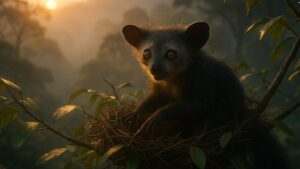
Aye-aye
The Aye-aye: Madagascar’s Most Mysterious Primate Deep within the rainforests of Madagascar lives one of the world’s most unusual and captivating creatures: the Aye-aye (Daubentonia madagascariensis). With its oversized ears, luminous eyes, bushy tail, and signature skeletal middle finger, the Aye-aye defies expectation and classification. To some, it resembles a gremlin; to scientists, it is a marvel of evolutionary adaptation. Long misunderstood and shrouded in myth, this nocturnal lemur continues
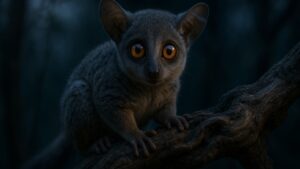
Bush Baby
The Bush Baby: Africa’s Enigmatic Night Acrobat Hidden in the shadows of Africa’s woodlands and forests lives a tiny, wide-eyed creature whose agility and charm have made it the subject of both scientific curiosity and local folklore—the Bush Baby. Known scientifically as members of the family Galagidae, these pint-sized primates are also commonly called galagos. Though small in stature, bush babies possess an impressive array of adaptations that make them
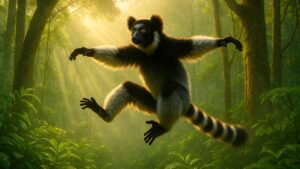
Indri
Indri: The Singing Sentinel of Madagascar In the ancient rainforests of Madagascar, where the morning mist clings to towering trees and the jungle hums with life, a haunting song pierces the stillness. Long, wailing calls, rising in eerie harmony, echo through the canopy. These are the voices of the indri (Indri indri), the largest of all lemurs, and one of nature’s most extraordinary primates. With its soulful eyes, black-and-white fur,

Mouse Lemur
Mouse Lemur: The Pocket-Sized Primate of Madagascar In the moonlit forests of Madagascar, where shadows stretch long and the air hums with the soft chatter of nocturnal life, a tiny primate stirs. Barely the size of a teacup and lighter than a deck of cards, the mouse lemur is one of the smallest primates on Earth. Belonging to the genus Microcebus, this miniature marvel has long fascinated scientists and enchanted
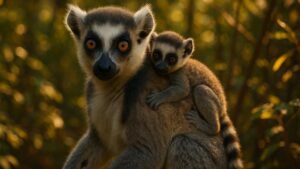
Ring-tailed Lemur
Ring-tailed Lemur: The Striped Spirit of Madagascar There is perhaps no primate more iconic or instantly recognizable than the ring-tailed lemur (Lemur catta). With its bold black-and-white striped tail waving like a flag and piercing amber eyes, the ring-tailed lemur is more than just a charismatic face of Madagascar’s biodiversity—it’s a symbol of a place and a story that spans millions of years. Known for its unique appearance, vocal communication,
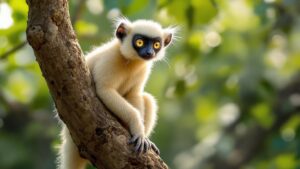
Sifaka
Sifaka: Madagascar’s Leaping Lemur In the wild and whimsical world of Madagascar’s primates, few are as iconic, charismatic, or peculiar as the sifaka. Belonging to the genus Propithecus, sifakas are a group of lemurs renowned for their extraordinary leaping abilities, upright posture, and distinctive mode of terrestrial locomotion that resembles dancing. With their bright eyes, velvety fur, and long, powerful legs, sifakas capture both scientific curiosity and public admiration. But

Slow Loris
The Enigmatic Slow Loris: Nature’s Nocturnal Acrobat In the hush of twilight across Southeast Asia’s dense tropical forests, a wide-eyed, fuzzy creature begins its silent descent through the canopy. Its movements are unhurried, calculated, and nearly imperceptible. This is the slow loris, a primate so peculiar and mysterious that it defies the expectations typically associated with monkeys and apes. Belonging to the genus Nycticebus, the slow loris is a rare
Biology and Evolution: Why Prosimians Matter
Prosimians are the most basal or primitive members of the primate order. Their lineage diverged from other primates tens of millions of years ago, giving them unique biological features not found in monkeys or apes. Most are nocturnal and have excellent low-light vision, thanks to a reflective layer behind the retina known as the tapetum lucidum. They also possess a more developed sense of smell than other primates and rely heavily on scent marking to communicate. Unlike monkeys and apes, prosimians generally have a more limited social structure, though lemurs are notable exceptions. Many are solitary foragers that communicate through scent, sound, and occasional vocal calls. Their smaller brains, in proportion to body size, are more specialized for survival in specific environments rather than complex social navigation. Yet, despite their “primitive” label, prosimians are remarkably well adapted, resilient, and in many cases, strikingly intelligent.
Lemurs: Madagascar’s Primate Marvels
Lemurs are found exclusively in Madagascar, where they evolved in isolation for over 60 million years. This separation allowed them to diversify into over 100 species, from the tiny mouse lemur that fits in the palm of your hand to the indri, which stands nearly three feet tall. Lemurs are diurnal, nocturnal, and cathemeral (active both day and night), and inhabit a variety of habitats ranging from lush rainforests to arid spiny forests. Ring-tailed lemurs are perhaps the most iconic, instantly recognizable by their long black-and-white tails. They live in female-led social groups and spend more time on the ground than most other lemurs. Their vocal communication is sophisticated, and they engage in sunbathing, grooming, and even “stink fights” using scent glands. Sifakas are known for their dramatic mode of terrestrial locomotion, appearing to dance across the forest floor on their hind legs with arms raised for balance. Their powerful legs allow for extraordinary leaps through the canopy, where they forage on leaves, fruit, and flowers. Species like the Verreaux’s sifaka and the critically endangered silky sifaka highlight the grace and vulnerability of these arboreal specialists. Aye-ayes, with their large ears and long, skeletal middle finger, are among the strangest and most fascinating lemurs. They use percussive foraging—tapping on wood to locate hollow areas where grubs hide, then extracting them with their specialized finger. Considered omens of bad luck in Malagasy folklore, aye-ayes are often persecuted and face steep conservation challenges. Mouse lemurs, the world’s smallest primates, are nocturnal insectivores that weigh less than two ounces. Their rapid reproductive cycles and adaptability make them surprisingly resilient, but habitat loss remains a pressing threat.
Lorises and Galagos: The Night Watchers of Asia and Africa
Lorises, found in South and Southeast Asia, are slow-moving nocturnal primates with large forward-facing eyes and powerful grips. They are adapted for stealth and silence, often freezing in place to avoid detection by predators. Slow lorises possess a toxic bite—a rarity among mammals—produced by a gland near the elbow. When threatened, they lick this gland and deliver venom through their bites. These quiet primates primarily feed on insects, fruits, and gums, moving with deliberate precision along tree branches. Their social behaviors are subtle but present, with mother-offspring bonds and occasional grooming interactions. Lorises are threatened by habitat destruction and illegal wildlife trade, especially for use as exotic pets.
Galagos, or bush babies, are Africa’s answer to lorises. These small, nimble primates have oversized ears and enormous eyes adapted for nocturnal life. Unlike lorises, bush babies are incredibly agile and fast, capable of leaping several feet in a single bound. They communicate through a wide range of vocalizations, from clicks to shrieks, and rely on scent-marking for territory management. Bush babies feed on a mix of insects, tree gums, and fruit. They often live in small family groups and sleep in nests or tree hollows. While widespread and less endangered than other prosimians, they remain elusive due to their nocturnal and arboreal habits.
Tarsiers: The Evolutionary Enigma
Tarsiers are the only prosimians that are entirely carnivorous, feeding on insects, lizards, and even small birds. Found in Southeast Asia, particularly the Philippines and Indonesia, tarsiers are evolutionary outliers with traits that bridge the gap between prosimians and monkeys. Their enormous eyes—each larger than their brain—give them exceptional night vision, and their ability to rotate their heads nearly 180 degrees enhances their ambush-hunting style. Tarsiers have long fingers and powerful hind legs, allowing them to launch themselves from branch to branch with precision. They live in small family groups and communicate through high-frequency vocalizations that are inaudible to the human ear. Tarsiers are highly sensitive to habitat disturbance and are increasingly threatened by deforestation and human encroachment.
The Ecological Role of Prosimians
Prosimians play vital roles in the ecosystems they inhabit. Many are important pollinators and seed dispersers, aiding in forest regeneration. Their diets, which include fruits, flowers, nectar, and insects, influence plant reproductive cycles and help maintain biodiversity. Lemurs, in particular, are considered keystone species in Madagascar, meaning their ecological impact is disproportionately large relative to their numbers. By consuming and spreading seeds, prosimians support the growth of fruiting trees, which in turn sustain countless other animals. Their movements through the forest also aid in aerating soil and distributing nutrients. Insects consumed by lorises, bush babies, and tarsiers help control pest populations and promote plant health. Prosimians are also prey for a variety of predators, from raptors and snakes to carnivorous mammals, making them crucial links in the food web. As their populations decline, entire ecosystems risk destabilization.
Cultural Significance and Scientific Value
Throughout history, prosimians have held spiritual, mythological, and practical significance. In Madagascar, lemurs are often woven into folklore as ancestral spirits or supernatural beings. While this can provide them with cultural protection, it can also lead to misunderstanding and persecution, especially in the case of species like the aye-aye. Scientifically, prosimians offer critical insights into primate evolution, sensory adaptation, and behavior. Their unique traits allow researchers to study how early primates may have lived and evolved into the monkeys, apes, and humans we see today. Prosimians also contribute to medical and neurological research, particularly in areas like sleep cycles, vision, and olfactory processing. Ethical concerns around captive research and conservation have shifted attention to non-invasive, observational fieldwork, where prosimians continue to reveal surprising intelligence, memory, and adaptability.
Conservation Challenges and Global Importance
Prosimians are among the most endangered mammals on Earth. Over 90% of lemur species are threatened with extinction, making them the most endangered group of mammals globally. The primary threats include deforestation, agriculture, mining, hunting, and illegal pet trade. Madagascar’s forests are being cleared at an alarming rate for slash-and-burn agriculture, charcoal production, and timber export. Many prosimians are also hunted for bushmeat or captured for traditional medicine and the exotic pet trade. Weak enforcement of environmental laws and political instability exacerbate the situation. Conservation efforts are underway through a combination of protected areas, community-based programs, ecotourism, and reforestation initiatives. Organizations such as the Lemur Conservation Foundation, Durrell Wildlife Conservation Trust, and Madagascar Biodiversity Partnership are leading the charge to save these remarkable primates. International support is also critical. Sustainable development, responsible tourism, and consumer awareness (such as avoiding products that contribute to deforestation) can all help protect prosimian habitats. Education, both local and global, is key to changing perceptions and ensuring long-term stewardship.
Why Lemurs and Prosimians Deserve Our Attention
In the grand story of life on Earth, prosimians are the ancient storytellers. They are living fossils, ecological engineers, and charismatic ambassadors for conservation. Their expressive eyes, varied vocalizations, and diverse behaviors captivate the imagination and invite us to understand nature not just as a resource, but as a family of living wonders. Every lemur call that pierces the morning mist, every bush baby leap across an African tree, and every cautious gaze of a loris in the moonlight is a thread in the tapestry of biodiversity that holds our world together. These creatures are not relics of the past—they are vibrant members of our planet’s future. Explore their stories. Learn their names. Share their plight. The more we know about lemurs and prosimians, the more we understand our own roots—and the more we are inspired to protect what is irreplaceable.

